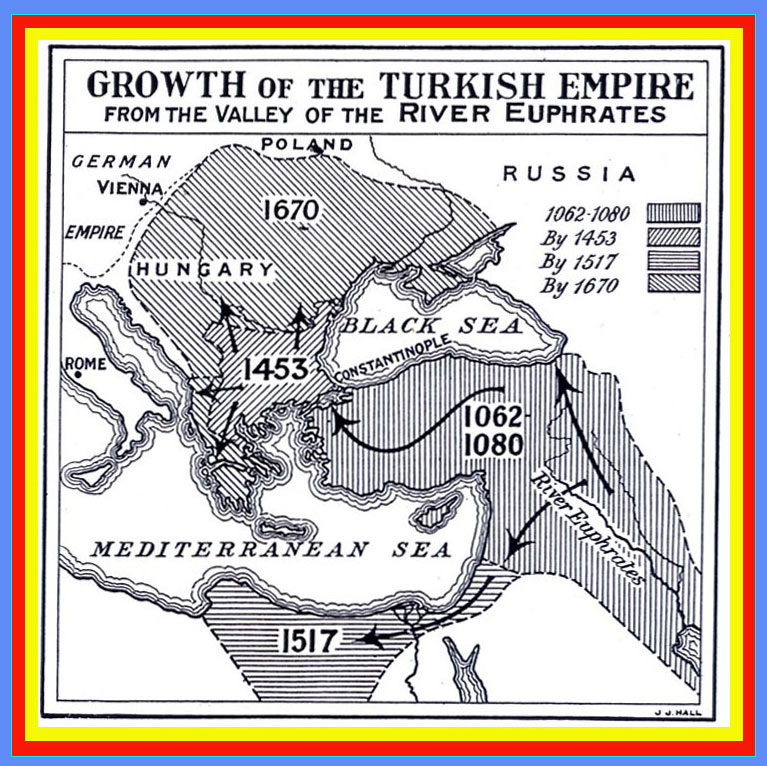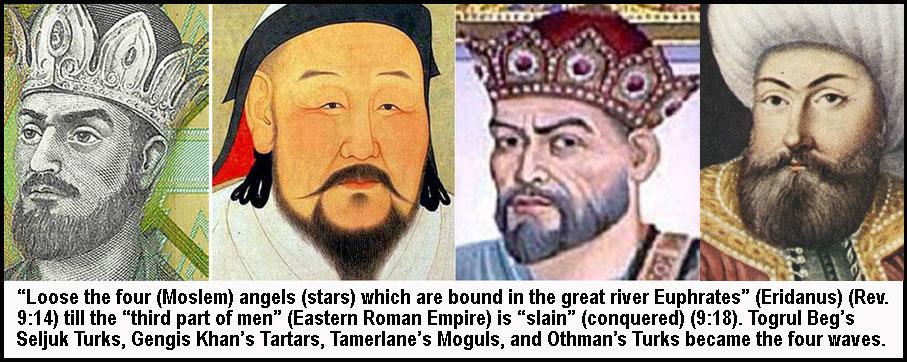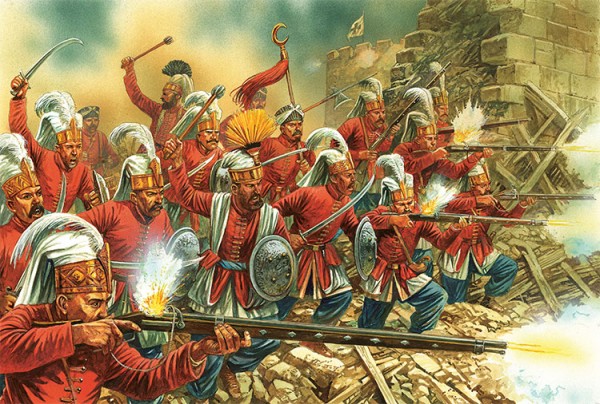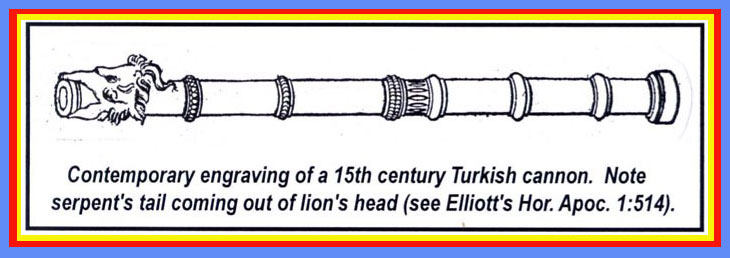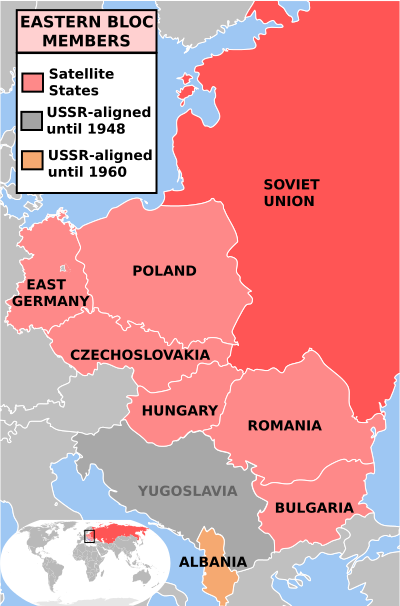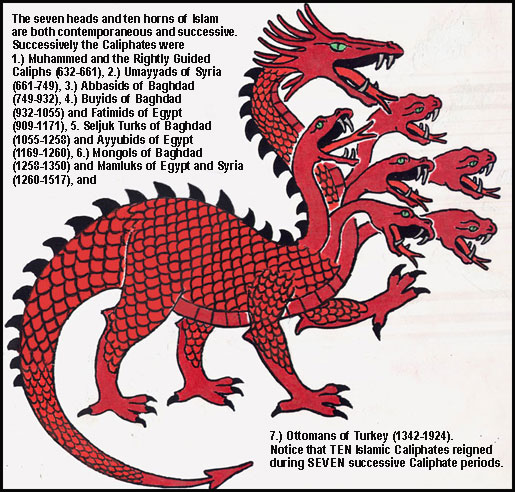TURKEY in Prophecy
This article is written from the historicist interpretation of prophecy.

Chapter 9b Star Chart: Mohammed "opened the bottomless pit" (9:2) by putting the lunar Kaaba stone key in the (Hydra coil; Capricorn lunar cavity key) hole in 606 A.D. Notice the radius line "hair like women's hair" (long) (9:8). These radius lines also represent blue and red "breastplates" (9:17), and "a voice ... Saying ... Loose the four angels who are bound in the great river Euphrates" (9:13-14), as well as the silhouette outline of the Kaaba itself and curtains hanging down on each side of the golden Kaaba doors which bisect the golden circles on the doors. Notice the black stone's silver frame with a marble (red radius) line for counting laps. The golden circle on each Kaaba door is the name Allah in a sun symbol with 12 rays. "The heads of lions" (Cetus and Leo) shoot "out of their mouths" (cannons; rifles) "fire and smoke and brimstone" (red and blue radius lines with fiery yellow cannon balls) (9:17), and the blue line also illustrates the water of the Euphrates (Eridanus) and the smokey trail as "a star fall(s) from heaven" near Leo (9:1).
|
|---|
Chapter 9b -- Moslem Turks Kill Eastern Byzantine Third of EmpireWhat does the Bible say about the Ottoman Empire? Did the Bible predict the fall of Constantinople? How do we calculate the 391 years? Why did the Turks attack the Byzantine Empire? The sixth star in Ursa Minor took his Spanish/Portuguese hunting horn -- the Bocina or Shofar; or the red radius tube with sun-bell end -- and blew it. The four stars are "loosed" simultaneously as well as in succession. According to the Historian's History of the World, "The mystic number FOUR is taken as the base of the governmental hierarchy in honour of the FOUR angels which carry the Koran, and the FOUR Caliphs, disciples of Mohammed." They are sent to punish the "FOUR heads," "FOUR wings" (Dan. 7:6) and "FOUR notable HORNS" (Daniel 8:8,22) of Alexander's GREEK Empire now in Roman form. The FOUR archangels celebrated in Islam are Munkar, Nakir, Harut and Marut who are all allegedly under the control of Iblis or Shaitan (alias the Devil). The prince commissioned by the Caliph to attack the GREEK Empire was named Togrul, but dying, his son, Alp Arslan, led the Turks across the Euphrates, and when he was slain in battle, he was succeeded by Malek Shah. Gibbon says, "Malek Shah's empire was divided up into FOUR principalities under his FOUR sons, Persia, Kerman or India, Syria and Roum or Asia Minor" (vol. 5 p.532). There were FOUR simultaneous Sultanates of Turks bordering the Euphrates. They were Baghdad founded in 1058, Damascus and Aleppo in 1079 and Iconium in 1080. There were FOUR successive waves of Turks that devastated the eastern Greek third of Europe: Togrul Beg's Seljuks, Timour's Moguls, Gengis Khan's Tartars and the Ottoman Turks -- all spread over a period of nearly FOUR HUNDRED years. (Esau had "FOUR hundred men" -- Gen.33:1. Turks controlled Jerusalem for 400 years: 1517-1917 -- cp. Gen. 15:13). They are associated with names famous in history -- Togrul Beg, Alp Arslan, Tamerlane, Bajazet, and so on, the leaders of the Ottomans or Turcomans. FOUR BRASS HORNS of the (Capricorn) altar (Rev. 9) correspond to FOUR HORNS of the shaggy goat (Dan. 8) and the belly and thighs of BRASS (Dan.2). The Ottoman Empire had FOUR successive capitals: Sogut, Bursa, Edirne and Istanbul. Who are the Turks? The people known as Seljuks are Turcoman (Togarmah) from Japheth (Gen.10:3) but the Ottomans take their name from Teman (Genesis 36:8-11; Obadiah 9), son of Esau. Ezekiel 35 and 36 tell us that those who have trodden down Palestine and Jerusalem are "Edom" or Esau. We know that the Turks are the ones who for centuries have trodden down Jerusalem and Palestine. Astronomically there are FOUR bright STARS in the Eridanus (Euphrates) River. Historically, the next scourge of Christendom, the TURKS or second woe, arose in the east 130 years after the first woe of the Arabs. Revelation 9:12 occupies this interval. Both were MOSLEM. The TURKS were to "slay" what the Arabs only "torment." "The Turkish invasion was a scourge far heavier than that of the Saracens. While the latter when bent on permanent conquest offered the tribute as alternative to the 'koran or the sword,' the Seljouks were mere savages who slew for the pleasure of slaying" (Oman, "Art of War" p.222). The TURKS were the "little horn" of Daniel 8. The home of the original TURKISH people was in the delta of the River EUPHRATES -- hence the use of the EUPHRATES symbolism. The river symbolically "OVERFLOWED its banks" as the Seljuk (1062 to 1299 A.D.) then Othman dynasties (Ottomans became independent in 1299 A.D.) expanded. (Later, in Rev. 16:12, as the Turkish Empire decays, we read that "The River Euphrates DRIED UP."). "And the four angels were loosed, which were prepared for an hour, and a day, and a month, and a year, for to slay the third part of men" (9:15). At the beginning of each cycle the sun is in the head of Sagittarius (9:7) forming a left-face lunar goat horn on Capricorn's head -- planting a crescent on Greece (the goat of Daniel 8). At the end of each cycle it is under the left hand of Aquarius making 391 degrees or years or "an hour (30 days -- John 11:9), and a day (1 year -- Num. 14:34), and a month (30 years), and a year (360 years)" (9:15). In other words, the cavalry flood out of the Euphrates (9:14) from the open bucket of Aquarius with the sun-lid removed. This forms a right-face lunar goat horn on Capricorn's head -- planting another crescent on Greece. Together these two opposing crescents add up to 30 degrees representing the extra month or "hour". They also form what appears to be an ECLIPSE. This 391-year period is the most accurate soli-lunar cycle under 1000. In fact, the Biblical periods of 391, 486, 1260, 2300, and 2520 years are all soli-lunar cycles with an error of less than a day. Furthermore, the number 391 is the most accurate ECLIPSE cycle (embracing a whole number of years) in existence. In fact, it is the only solar year, lunar year, ECLIPSE year cycle in existence. For instance, 391 solar years = 403 lunar years = 412 ECLIPSE years. The ECLIPSE year is simply the time occupied by the sun in passing from one of the nodes of the moon's orbit to the same node again. How appropriate that an "ECLIPSE cycle" should be used to describe the duration of Islam that darkens the sun (Rev. 9:2-3). The new moons and ECLIPSES -- in every year there are, at least, two solar ECLIPSES -- must occur on the same days of the year every 391 years. It is interesting to note that 2691 solar years, which is to the nearest year 1260 synodic revolutions of Mars, is a soli-lunar cycle, the sum of the two Biblical cycles 2300 and 391. It is also interesting that the most accurate anomalistic cycle (the time it takes for the moon to return to the corresponding point on its elliptical orbit), viz. 1336, is the difference between 1727 and 391. (see Soli-Lunar Cycles In Greek Research and Jewish Revelation by Walter S. Ridgway, UBC, 1946). This cycle happens four times because there are four stars making four horns total per set. The FOUR HORNS of the GOLDEN (Capricorn) altar (9:13) correspond to the FOUR HORNS of the shaggy goat (Dan. 8) -- two of which are lunar crescents illuminated by the SUN. The River Eridanus contains four bright stars (9:14) (or angels -- Rev. 1:20) that each rotate for 391 degrees or years (9:15) and slay one third of the zodiac (eastern Europe) using a 200-million-star army (9:16). From 1062 when Alp Arslan crossed the Euphrates at the head of the Turkish cavalry till 1453 A.D. when the Turks conquered Constantinople is one fulfillment but there were FOUR fulfillments causing FOUR complete 391-degree rotations. The span of the truce granted to Richard "the Lion-Hearted" by Saladin (1187 A.D.) was for "three hours, three days, three weeks, three months, three years" all added together (Elliott 1:528-530). But notice that "HOUR," "DAY," "MONTH," and "YEAR" are FOUR words concerning time and we have seen the significance of "FOUR" ALREADY. Togrul Beg was invited by the Caliph of Baghdad to quell a rebellion by his subjects. When he completed this task, Togrul was declared Lieutenant of the Caliph and invested with the title of Protector and Governor of the Moslem Empire. He went to war against the Eastern Byzantine Empire, defeating their army and slaying an estimated 100,000 Greeks. He and his successors conquered Armenia, Asia Minor, Arabia Felix, Jerusalem and the neighborhood of Constantinople. The Crusaders then intervened to recover the Holy Land; and their attempts lasted from 1097 A.D. to 1291 A.D. when they were driven from Palestine. This DELAYED Constantinople's destruction. Then Turks crossed into Europe conquering more and more of the remaining "THIRD" -- Bulgaria (1389), Salonica (1430), Serbia (1438) and Greece (1446). But an unseen HAND DELAYED Constantinople's capture. For instance, Ghengis Khan DIED while marching against it. His brother Borga was DIVERTED from the Byzantine War by an alliance with Mameluks against Moguls of Persia. Holagau, grandson of Ghengis, was DISTRACTED from destroying it by war with Moslems of Baghdad and Syria, causing Holagau to unite with the Greeks. Bajazet was OVERTHROWN and taken captive by Tamarlane as he closed in on Constantinople in 1402. He died in 1403. By 1453 practically the whole Eastern Roman Empire had fallen to the Turks except its capital, Constantinople, which fell 29th of May. The Turkish power began when Togrul Beg, their first military leader, married the daughter of the Caliph of Baghdad on April 27th 1062 A.D. (the head of the Arab-Moslem religion), and became head of the Mohammedan faith, establishing himself in Islam. He died the same year and was succeeded by Alp Arslan, the "valiant lion" who, setting out from Baghdad, "passed (crossed) the Euphrates at the head of the Turkish cavalry" (Decline & Fall, Gibbon ch. 57, p.12) in 1062 A.D. and waged a holy war against Greek "Christendom" which by this time had once again become idolatrous because the Empress Irene convened the Second Council of Nicea which declared idols lawful and by the Ninth Century idolatry reigned supreme in both east and west. Algol, the chief star in the head of Medusa, is the most changeable star in the heavens, expressive of Satan who kept not his first estate, and sought to be worshipped. Finally Turkey completed the capture of Constantinople May 29, 1453 A.D. and slew the eastern Roman emperor. The Greek or Byzantine "THIRD" of the Roman Empire passed to the Turks under the 6th Trumpet. This THIRD was KILLED politically and religiously if not physically (cp. Hos. 13:1). The city named for the first Christian emperor was now in the hands of Islam and its Cathedral of St. Sophia, the center of Eastern Orthodoxy, was turned into a Moslem mosque. Other churches erected to departed spirits of saints (demons), were converted to mosques by the victorious Turks. The patriarch of the Greek Catholic Church, originally stationed in Constantinople, fled to Moscow, where he set up his power, and which became known as the Third Rome. The Goths already had the western THIRD under the first Four Trumpets and the Arabs the southern THIRD under the Fifth Trumpet. A SECOND method of figuring the time interval is even more precise than the previous method. There are two Greek words for "year." The first is "kairos" meaning 360 days and the second is "eniatos" meaning 365 days 5 hours 49 minutes. John used the second. Nowhere else in scripture is "eniatos" used. Therefore an "hour" calculates out to 30 days since there are "twelve hours in a day" (365/12 = 30.4). The "day" is one year. The "month" is 30 years. The "year" is 365 years 91 days. The total is 396 years, 121 days. From 18th of January 1057 A.D. (given by Abulfeda as the 10th of Dzoulcaad) when Togrul Beg left Baghdad at the head of a Moslem Turkish force and began the conquest of an empire -- that would last for 9 MORE CENTURIES -- till the 19th of May, 1453 when Turk cannon fire continued by day and night, with sections of the wall of Constantinople being continually knocked to the ground (Diary of Nicolo Barbaro) beginning a conquest of a city -- that would last for 9 MORE DAYS -- is exactly 396 years, 121 days. Constantinople fell on the 29th May -- 9 DAYS LATER (from Gibbon's Decline and Fall 7:199 or Langer's Encyc. of World History p.327), just as the Ottoman Empire fell in 1924 -- 9 CENTURIES LATER. Other commentators prefer to account for the nine days as the march of the Turks from the city of Baghdad on the Tigris, whence they started, to the actual passing of the Euphrates. A THIRD way to figure the 391-year interval is from 1453 A.D. to 1844 A.D., which is the 1260th lunar year of the Hegira or flight of Mohammed (Dan. 12:7; 622 + 1260 = 1844), when Britain and other Christian European nations forced the Sultan to sign the Decree of Toleration which abolished the death penalty for conversion from Islam to Christianity or any other religion. Also 1290 lunar years from 622 A.D. is 1873. From that date on she began to decline until by 1917 (622 + 1335 = 1917) on the 1335th lunar year, Turkey was driven from Jerusalem and Palestine by Great Britain's General Allenby. "And I will lay my vengeance upon Edom by the hand of my people Israel" (Ez. 25:14). Then in 1948, Zionist Jews challenged Britain's right to Palestine. "The house of Israel ... are they unto whom the inhabitants of Jerusalem have said, Get you far from the Eternal; unto us is this land given in possession" (Ez. 11:15). To digress, in 1299, the Turkoman power was revived under Ortogrul, father of Othman (whence the term Ottoman), who united together the four sultanates of Turks bordering on the Euphrates -- at Baghdad founded in 1058; at Damascus and Aleppo in 1079; and at Iconium in 1080 -- aptly prefigured in the four angels bound in the Euphrates. "On the 27th of July, 1299, Othman first invaded the territory of Nicomedia" (Gibbon ch. 64). Ortogrul had previously obtained the FIRST Ottoman Turk VICTORY over Christians by capturing the city of Kutani in 1281. The Ottoman Turks obtained their LAST VICTORY by taking the Cameniec territory from the Poles in 1672, this conquest marking the limits of their territorial expansion which never extended beyond the original boundaries of the Byzantine Empire. The 391 years between 1281 A.D. and 1672 A.D. is yet a FOURTH way to figure the interval. Actually there are FOUR SETS of 391-year and 396-year periods grouped under four Turkish capitols. Twenty-seven years later the "drying up" of the Ottoman Empire (Rev. 16:12) began in earnest in 1699, by the Treaty of Carlowitz, following the wars with Austria and Russia, and it has never ceased to recede till finally extinguished on March 6th, 1924, 666 years (the number of a man representing a dynasty -- Rev. 14:18) from the birth of its founder, Othman, in 1258. The office of Sultan-Caliph was abolished by Mustafa Kemal (Ataturk) on March 1924. This is confirmed in Daniel 12:11, being 1290 solar years from 634 A.D., when Omar (the "desolator"), who set up the "abomination" here referred to, succeeded to the Caliphate. "And the number of the army of the horsemen were two hundred thousand thousand: and I heard the number of them" (9:16). This refers to a 200-million-star army or Greek "two MYRIADS of MYRIADS " or two armies (Seljuks and Ottomans) of 10,000 x 10,000 (9:16). If each myriad symbolizes an army (e.g. as in Xenophen's "Descent of the 10,000"), then the phrase means "two armies of armies" and the main Turkish groups responsible for the fall of the eastern Roman Empire were Seljuks and Ottomans -- two armies. Remarkably, Turks were in the habit of reckoning their forces by "myriads" or groups of 10,000 men which they termed "tomans." Gibbon mentions, "the MYRIADS of the Turkish horse overspreading the GREEK frontier" and "both men and horses, proudly compute by MILLIONS" (7:287, p.351). "The MYRIADS of Turkish horse overspread a frontier of 600 miles from Taurus (near Tarsus) to Azeroum (Black Sea) and the blood of 130,000 Christians was a grateful sacrifice to the Arabian prophet." (Gibbon, Decline & Fall Vol VI p. 252). "200,000 soldiers marched under his banners" (Vol VI p.260). Gibbon said regarding Timur the Lame (the leader of the Tartars or Eastern Turks from Mongolia), "The Sea (Bosporus) rolled between the two continents of Europe and Asia and the lord of so many TOMENS or MYRIADS of horse was not master of a single galley." ("Decline & Fall" Vol VII p.72). The number of horsemen used by the Turks, not all at once, but over the course of 1062 to 1924 A.D. may have been this high. "And thus I saw the horses in the vision, and them that sat on them, having breastplates of fire (red radius line), and of jacinth (blue sky), and brimstone (yellow sun): and the heads of the horses were as the heads of lions (Leo and Cetus); and out of their mouths (cannons; rifles) issued fire and smoke and brimstone" (9:17).
Historically Togrul's successor was Alp Arslan whose name means the "Valiant Lion." Other Turkish leaders had similar names. Alp Arslan's successor was named "Kilidge Arslan" which means the "Noble Lion." "The Turks compare their king to the lion and other kings to little dogs" (Gibbon 7:72). Like the lion, Turks are known for their courage and destructiveness. Their "breastplates of fire (red), and jacinth (blue), and brimstone (yellow)" (9:17) describe the colors of Turkish uniforms as well as sunrise against a blue sky (shown above) as well as gunpowder which burns with a characteristic blue-red color from the potassium in the saltpetre. Daubuz, an English scholar writing of this time says, "From their first appearance the Ottomans have affected to wear warlike apparel of scarlet, blue and yellow: a descriptive trait the more marked from its contrast to the military appearance of Greeks, Franks or Saracens [Arabs] who were contemporary." (Elliott "Horae Apocalyptica" ch VII p.508) The lion-head was then, and is now, a notable ensign among the Turks. It is fascinating to learn that the Ottoman Turks in particular, were a great aid to the Protestant Reformation. When Turks were invading Europe, King Charles V of Spain was Emperor of the Holy Roman Empire. This was the Roman Catholic political empire of the Middle Ages. Protestantism had risen in 1517 and thousands of people had left Mother Church to become Protestants. Charles V, being a devout Roman Catholic was fervently pursuaded by his church, not only to oppose the Protestant faith, but to destroy it (Eugene Lawrence "Historical Studies" p.96.). But whenever he advanced to attack the Protestants, so often tidings would come that the Turks were on the attack and Charles would be forced to turn away from the Protestants and march against the Turks. History is very clear that had it not been for the Turks, Protestantism would never have survived. As one scholar says, "In the 16th and 17th centuries support and encouragement for Protestants and Calvinists ... were one of the fundamental principles of Ottoman policy." (Halil Inalcik "The Heyday & Decline of the Ottoman Empire!" in "History of Islam" pp.325-329.) Another declared, "There would have been no Protestantism had there been no Turk." It has since been revealed that there was an agreement between the Turkish sultan and some of the minor powers of Europe including German barons. It was agreed that whenever Charles V would exert his political strength, especially against Protestants, the Turks would attack Europe and divert Charles' attention. No wonder Charles in utter frustration finally buried himself in the monastic life and handed over the kingdom to his son, Phillip II. His last words to Phillip were "Take care that the heretics ... were repressed ... without regard to any plea in their favor." (Kenneth Oster "Islam Reconsidered" p.72. Quoted by M.Maxwell "God Cares II" pp.255-256). Phillip certainly endeavored to fulfill the wishes of his father and also of his church. "By these three was the third part of men killed (Eastern third of Roman Empire), by the fire (red radius lines), and by the smoke (blue radius lines), and by the brimstone (yellow cannonballs), which issued out of their mouths" (rifle and cannon barrels) (9:18). In early 15th century Turkey, a sultan named Mahomet II ascended the Turkish throne. He named himself "Huukiar" which means "the slayer of men." This prophecy he fulfilled with the final destruction of Eastern Rome. His unrelenting resolve was to take Constantinople: "I ask a present far more valuable and important -- Constantinople," he proclaimed (Gibbon "Decline & Fall!" Vol VII p. 192). In inspiring the Turkish armies to capture Constantinople he assured them that ...the door would open to them by its capture, to conquer the whole of the Greek empire (i.e. Eastern Rome) (Sir Edwin Pears "The Destruction of the Greek Empire!" p.324). How correct his words proved to be. In preparation, he studied the latest instruments of destruction with which he might bring Constantinople to its knees. Especially gunpowder and artillery. Not that any European powers had yet used it successfully, but they were progressing. Before long a constructor or founder of cannon, because of improper treatment by the Roman emperor at Constantinople, deserted to the Turks. What a windfall! Mahomet's first question to him was, "Are you able to cast a cannon capable of throwing a ball that would batter the walls of Constantinople?" The answer was in the affirmative. As a result, a foundry was immediately established and within three months a cannon was produced with a bore of five feet. It was able to blast a 600 lb missile for several furlongs and bury itself in the earth (Gibbon "Decline & Fall" Vol VII pp.193-195). Now the prophecy stated that "fire, smoke and brimstone came out of" their mouths. With the invention of muskets [or rifles], Turkish horsemen acquired the skill of using them while riding or charging on horseback into battle. As they charged they fired their muskets chest-high making it appear to come from the horses' mouths. Furthermore, it appeared as if "fire and smoke and brimstone came out of the" man's mouth. When a rifle is held up to a man's shoulder to look through the gun sights, it appears as though the fire comes from the man's mouth just as the two-edged sword comes out of Christ's mouth. Lastly, "fire, smoke and brimstone" came from the rifle's mouth. But were not other nations also using gunpowder? They were experimenting, but the Turks were the first to successfully employ gunpowder in the prosecution of warfare. "For their power is in their mouth, and in their tails (scimitars look like tails when worn on soldiers' belts; cannons pulled behind horses): for their tails were like unto serpents, and had heads, and with them they do hurt" (9:19). Maybe this is one reason why this detail is featured in this prediction." "Their power (or authority) is in their mouths, and in their tails." In other words, their authority "was in their tails and their tails were like unto serpents and had heads" (v.19). In Scripture the word "power" may signify authority (Rom.13:1). The word "heads" could indicate rulers or leaders in association with the horse tails. "Power ... in their (horse's) TAILS" (9:19) may refer to the official badge of the Sultans and Pashas which was HORSE-TAILS attached to crescents ("heads"). The Sultan had seven HORSE-TAILS borne before him, the Pashas (governors of provinces) had one, two or three HORSE-TAILS according to their rank (Elliott ch. VII p.514 footnote). They were responsible for all the oppression, injustice, cruelty and harsh taxation in the Ottoman Empire. How did this ensign originate? In their early days, the Turkish tribes carried the ensign representing the horse-like tail of a yak. According to their history, "a general of theirs, not knowing how to rally his troops, they having lost their ensigns, cut off a horse's tail, and fixed it on the end of a spear: the soldiers rallying at this signal, gained the victory" (Tournefort's Travels; also Elliott ch VII p.514 Footnote). Thereafter the horse's tail was used as a symbol of office. These standards became known as Tughs. "With them they do hurt" (Rev. 9:19). The Greek word for "do hurt" means "doing injustice." We believe that this represents the oppression by the Turkish leaders on those whom they conquered, especially Christians in Greece and elsewhere. Knolles says, "His Bassaes like ravening harpies, as it were, suck out the blood of his poor subjects (referring to the Turkish Pashas or leaders)"(Knolles "Sketch of the Turkish Greatness"). The following is an eyewitness account of Turkish oppression. "Even now the scene rises in memory before the author, of a long train of a Turkish Pasha proceeding to his Pashalik [or governorship] in Greece; ... And bright, he remembers, shone the sunbeams on the varied colourings, the 'red, blue, and yellow' of the horses, horsemen and foot-retainers, in the procession; and proudly the ensign was borne before the Turkman of two horsetails, to mark his dignity. But associated with the remembrance there rise up other recollections also: the scene of a village which, on entering it a few days before with his companions, he had found deserted, though with marks of recent habitation; and from which, a straggler emerging from his hiding place informed them, men, women, and children had fled to the mountains, to escape from the visit, on some errand of oppression, of one of the officers of a neighboring Pasha. Nor again can the scene be forgotten of other permanently deserted villages ... and often with nothing but the silent graveyard in its loneliness, to tell the tale of former life and population. Thus was there set before his eyes how the inhabitants had failed before the oppressions of the Pashas." (Elliott Ch VII pp.515-516). Turkish Muslims also wore Fezes -- red hats with a black horse tail hanging from the top. This style cap originated when Moslems captured the city of Fez, Morocco while wearing white Fez caps. They dipped them in Christian blood and that's where the red Fez came from. Gradually they started to hang horse tails to these hats to show how important they were. The Sultan of Turkey had seven tails hanging from his hat. Others had three or less. We now come to the seige of Constantinople -- the final "killing" or "slaying" of the Eastern Roman Empire. On April 6, 1453 Mahomet II assembled 258,000 men to commence the attack. The city was 13 miles in circumference, with 7,000 - 8,000 men to defend it. Its people implored the virgin Mary for deliverance -- a token of their apostasy. The city was in the form of a triangle -- two sides ran along the sea [the Black Sea and the Bosporus] and the base of the triangle was protected by a double wall and a trench, 100 feet deep and six miles long. This part was attacked by the Turks." Gibbon wrote, "The volleys of lances and arrows were accompanied with the smoke, the sound, and the fire of the musketry and cannon ... the long order of the Turkish artillery was pointed against the walls; fourteen batteries thundering at once on the most accessible places ... the fortifications which had stood for ages against hostile violence, were dismantled on all sides by the Ottomen cannon, many breaches opened, and near the gate of St. Romanus, four towers leveled with the ground ... from the lines, the galleys and the bridge, the Ottoman artillery thundered on all sides, the camp and city, the Greeks and the Turks, were involved in a cloud of smoke, which could only be dispelled by the final deliverance or destruction of the Roman Empire ... the double walls were reduced by the cannon to a heap of ruins' ... the Turks at length ... rushing through the breaches ... Constantinople was subdued, her empire subverted and her religion trampled in the dust by the Moslem conquerors" (Gibbon Vol VII p.203.). "The Moslems placed their cannon in an effective position. The gates and ramparts of Constantinople were pierced in a thousand places. The flame which issued from the mouths of those instruments of warfare, of brazen bodies and fiery jaws, cast grief and dismay among the miscreants. The smoke which spread itself in the air rendered the brightness of day as somber as night; and the face of the world soon became as dark as the black fortune of the unhappy infidels." (Saadeddin's "Diadem of Histories" Cited by Dr. Keith Apoc. Vol. II, p.46.) The Turks defeated the Romans by using "Brimstone" or sulfur which is the basis of GUN POWDER (saltpetre, sulfur and charcoal) at a time when it had been recently invented. Gibbon mentions "fire of their (Turkish) MUSKETRY and CANNON" (Decline & Fall vol. 6, ch. 68, p.388).The Turks were the first to use cannons. Sultan Mohammed hired a Greek Christian engineer to cast cannons in a foundry to batter down the walls of Constantinople. Men were "killed, by the fire ... smoke and brimstone, which issued out of their mouths. For their power is in their mouth, and in their tails; for their tails were like serpents, and had heads, and with them they do hurt" (9:18-19). Cannons of the 15th century were called "basilisks" -- a name given to a fabulous serpent, the breath ("fire and brimstone") and even the look of which the ancients considered fatal. CANNONS pulled by horses are long, thin and round, so look like SERPENTS. When pulled they become TAILS; when swung around and fired the artillery becomes the "HEADS of LIONS" (Rev. 9:17) or ROARING GUNS, because the horse is now behind. A lion's head was cast around the cannon's mouth. The cannon was ignited by lighting a fuse at the BACK or TAIL. The CANNONBALL itself was also a "HEAD" striking like a snake. Muzzle-loaded from the front it rested in the TAIL. Turks discharged their FIREARMS on horseback and to an observer it would appear as if the fire issued out of the horse's mouths or the man's mouth when rifle sights are used. For similar Scriptural symbolism see Hab. 1:8; Joel 2:4-8; Isa. 5:21-30. The Sultan Mahomet possessed 67 cannons. Also, there issued "fire and smoke and brimstone" (9:17-18) The serpent HISS of cannonball "HEADS" is distinctly heard as they whiz through the air toward their target. Leo has a serpent-like tail. These "TAILS ... like SERPENTS" were "the PROPHET that TEACHES LIES he is the TAIL" (Isa. 9:15). Jesus called the religious leaders of his day "SERPENTS" (Matt. 23:33) (9:19). Persian Buyids ruled Baghdad from 932 till 1062. Seljuks took over from 1062 till 1258. Both used Abbasids as puppets. On April 27, 1062, Turkish leader Togrul Beg married the caliph's daughter establishing himself in Islam. He died the same year and was succeeded by Alp Arslan who crossed the Euphrates at the head of the Turkish cavalry (Gibbon ch.57, p.12) and waged a holy war against Greek Christendom which by this time had once again become idolatrous because the Empress Irene convened the Second Council of Nicea which declared idols lawful and by the Ninth Century idolatry reigned supreme in both east and west. Therefore, "an hour, and a day, and a month, and a year" (9:15), is exactly 391 years and one month later on May 29, 1453 A.D. when the Turks conquered Constantinople making one fulfillment. From 1453 till1844 when Great Britain compelled the Sultan of Turkey to sign a Decree of Toleration which abolished the death penalty for conversion to Christianity is a second fulfillment. The first Ottoman Turk victory over Christians by capturing the city of Kutani in 1281 to their last victory by taking the Cameniec territory from the Poles in 1672 was a third fulfillment. From 1527 when Suleiman the Magnificent laid seige to Vienna (high water mark) till the Fall of the Ottoman Empire in 1918 (low water mark) is a fourth fulfillment (and there are many more). "And the rest of the men which were not killed by these plagues yet repented not of the works of their hands (Catholic idols), that they should not worship devils, and idols of gold, and silver, and brass, and stone, and of wood: which neither can see, nor hear, nor walk: Neither repented they of their murders, nor of their sorceries, nor of their fornication, nor of their thefts" (9:20-21). Even so, the other constellations of the zodiac are busily engaged in worshipping idols and demons (Isis and Horus of Coma; Southern Cross; Northern Cross). Those who "worship demons and idols" (Rev. 9:20) were Roman Catholics and Greek Orthodox. Pagans worshipped through visible images, thereby compelling the actual spirit to be present. Mary-worship and saint-worship has followed the same principle. Proponents claim they do not actually worship the image. But the second commandment plainly forbids even the bodily act or posture, whatever be the intention behind it. Men naturally worship the female body anyway, so goddess-worship has always been popular. Using Mary and the saints as mediators between God and men contradicts 1 Timothy 2:5 mentioning the "one mediator ... Jesus Christ." Murder (Centaurus, Hercules, Orion, and Sagittarius caught in the act): Paulicians (679), Albigenses (1208-1218, 1229) of France, Waldenses (1237) in the Alps, Hussites and Moravians in Germany (1413) and the Lollards of England (1413) who were all regarded as "heretics" were killed. Rome has never repented of these murders, and would kill "heretics" today if she had the power. Sorcery (all constellations breathing hemp-seed or opium vapors [the Milky Way] from Ara -- Her. 4:73; mind-altering drugs relax inhibitions so demons can enter). "Sorceries" (Rev. 9:21) refer to pretended miracles and revelations such as Transubstantiation and visions also. (Crater and the solar disk portray transubstantiation and the sacrifice of the mass). Fornication (Hercules and Ophiuchus kissing; the Gemini twins making love; caused by enforced celibacy, auricular confession, monasteries and nunneries). Theft (Libra Scales of Justice unused; Serpens stealing the crown; the sale of indulgences for release from an imaginary purgatory, masses for the dead and otherwise extracting money from the dying, paying for religious offices and fictitious relics instead of trusting in the fully-paid pardon of Christ's sacrifice.). All this under the cloak of night (9:20-21). Just as the Egyptian plagues didn't cause Egypt to repent but instead Pharaoh's heart was hardened; so also the trumpet plagues didn't cause the Roman Empire to repent but instead the Pope's heart was hardened. There was no repentance till the Reformation. Why did God permit Moslems to defeat Christians? Because these "Christians" taught Transubstantiation and the sacrifice of the Mass, which deny the finished Atonement of Christ. That is why the voice that loosed the evil came from "the four horns of the golden altar" (9:13). The golden altar was the altar of incense in the Jewish Temple. On the Day of Atonement its four horns were anointed with the blood of a lamb without spot or blemish: "He shall put the blood upon the horns of the altar round about" (Ex. 30:10; Lev. 16:18). The blood signified the finished atonement of our Lord. But this was polluted when a monk named Paschasius Radbertus in the middle of the tenth century proclaimed Transubstantiation -- that the bread and wine were changed to the body and blood of Jesus at Communion by the priest's words: 'Hoc est corpus meum.' The doctrine was accepted by Pope Hildebrand and by 1022 A.D. twelve Protestant martyrs of Orleans were publicly burned at the stake for refusing to believe it. Devotion to saints and the "Virgin Mary" also polluted Christ's atonement. During the tenth century the invention of the Rosary came into use, a chain of beads that count recited prayers (vain repetitions) at a ratio of ten prayers to Mary for every one offered to God. In Revelation 16:12 the "FALSE PROPHET" is MOHAMMED. In World War One, pagan Germany joined forces with Papal Austro-Hungary and the Moslem Turks in the 6th Vial cup. According to many interpreters, the three frogs are the DRAGON (Satan or pagan Roman Empire), the BEAST (Roman Catholic Western Europe) and the FALSE PROPHET (Moslem Mohammedan Turkish Eastern Europe). Mohammed is called by his followers "the Great Prophet." Mohammed (Dan. 8) and the Pope (Dan. 7) are the two horns of Antichrist (Rev. 13) and the two legs of the Daniel 2 image from 610 A.D. onwards. Neither of these two horns regard the "desire of women" since Mohammed takes all wives but has none (no pretence of chastity or marriage -- men allowed to have four wives) and the Pope takes no wife but has all wives (celibacy). Both little horns deny Jesus is the Son of God (1 John 2:18-22). The Papacy by Transubstantiation and Moslems by saying that Jesus is not God incarnate. There is no Son of God in Islam. Both horns sit in the temple of God claiming to be God (2 Thess. 2:4). The Pope sits in the Vatican blaspheming while Caliphs and Sultans of Islam blaspheme in Mosques that are often merely converted churches. Saint Sophia is perhaps the best example of a church turned into a mosque. Also the Dome of the Rock sits on Temple Mount. The Turkish ruler had the title: "Emperor of Powerful Emperors; Refuge of Sovereigns; Distributor of Crowns to the Kings of the Earth; Keeper of the Two Very Holy Cities; Governor of the Holy City of Jerusalem; Master of Europe, Asia and Africa; High King of the Two Seas; The Shadow of God Upon Earth." "And the sixth angel poured out his vial (cup) upon the great river Euphrates; and the water thereof was dried up, that the way of the kings of the east might be prepared" (Rev. 16:12). Historically, the Sixth Trumpet or Second Woe (Rev. 9:13-21) was the rise and growth of the Turkish empire beginning in 1062 A.D. when the Turks crossed the Euphrates symbolized by conquering horsemen from the Euphrates Valley, as if the river itself had overflowed its banks and flooded Asia Minor and S.E. Europe. This sixth vial (cup) now reverses that process by the destruction and "drying up" of the Turkish Empire and Islam. Muslim Turkish armies continued to enlarge their empire until the decisive sea battle of Lepanto in 1571. In 1683 the Turkish army was defeated at the unsuccessful siege of Vienna and the final end of Turkish aggression westward was marked by the Treaty of Passarowitz in 1718 which removed the Turks from Hungary. In 1826 the Sultan massacred the flower of his army -- the Janizaries -- because of their complaining, dictatorial attitude. The Janissaries were the children of slaughtered Christian parents, brought up to renounce their faith and to work for the advance of Islam. Bureaucrats replaced them leading to internal decay. In 1829 Greece obtained independence from Turkish rule with help from both Britain and Russia. In 1844 Great Britain compelled Turkey to grant religious rights to minorities. The Crimean War (1853-1856) resulted in Moldavia and Wallachia becoming independent. The Turkish Empire was now known as the "sick man of Europe." In the Russo-Turkish War of 1878, England took Cyprus, Russia claimed parts of Asia, Greece took Thessaly, France grasped Algiers and Tunis, and Austria annexed Bosnia and Herzegovina. Serbia, Montenegro, Romania and part of Bulgaria were made independent. Just four years later in 1882, Egypt became a British Protectorate and in 1896 the followers of the Islamic prophet, the Mahdi, were defeated by Kitchener and the Sudan came under British control. Both had been Turkish provinces. In 1911 Italy declared war on the Turks and by the peace treaty of October 1912 modern Libya and some of the Aegean Islands passed into Italian control. Then the Balkan War of 1912-1913 resulted in an independent Albania and caused Turkey to shrink almost out of Europe with the spoils divided by Greece, Serbia and Bulgaria. In 1914-1918, British Imperial troops completed the drying-up process by driving the Turks out of Egypt, Palestine, Syria and Mesopotamia which included the actual valley of the Euphrates itself. On December 9th, 1917 Jerusalem was liberated by British General Allenby (cp. Haggai 2:10, 18, 20). Later in 1917, Major Vivian Gilbert, a British army officer, recalled reading in 1 Samuel 13 & 14 how Saul and Jonathan had defeated the Philistines at Michmash -- a village on a rocky prominence on the other side of a deep valley. Jonathan and his armour-bearer climbed up the cliff using a narrow passage through the rocks at night and overcame the sentries. The Philistines awoke to the noise thinking they were surrounded. The Philistines then fought eachother as they fled in confusion, and Saul pursued and defeated them. Gilbert woke the British brigade commander and showed him the Scriptures. The commander sent one company through the pass under cover of darkness. The few Turks they met were overpowered without a sound, the cliffs were scaled, and the company took up a position on the plateau of Michmash. The Turks woke up and fled in disorder since they thought they were being surrounded by Allenby's army. They were all killed or taken prisoner. After 3000 years, the British successfully copied the tactics of Saul and Jonathan. "So the Lord saved Israel that day" twice. "The mighty men of Edom shall be as the heart of a woman in her pangs" (Jer. 49:22). "I will lay my vengeance upon Edom by the hand of my people Israel" (Ez. 25:14). Turkish losses were formalized at the Treaty of Sevres (August 10, 1920). In November 1922 the Sultan of Turkey abdicated and fled his empire. In October 1923, Mustapha Kemal became president of the Turkish Republic. On March 6, 1924, the expulsion of the whole House of Ottoman occurred and the Turkish Caliphate was abolished. By constitutional amendment in 1928, Turkey ceased to have a state religion. Modern Turkey, a small republic in Asia Minor, possesses only the source of the Euphrates. This cleared the way for certain "kings of the east" (Lenin, Stalin, Kruschev, Breshnev) to move across and then destroy "Babylonian" civilization under the final seventh vial (cup). Ancient Babylon fell when the Medo-Persian "kings of the east," Cyrus and Darius, diverted the Euphrates River from its course "by a canal into the basin ... a marsh" (Her. 1:191). As Jeremiah 50:38 says, "They must be dried up." Then Cyrus entered underneath Babylon's walls along its dried-up river-bed and conquered the city. In the anti-type, the way was prepared for the advance of modern "kings of the east," Soviet Russia (the Medes) into Moslem eastern Europe (Babylon) to destroy its civilization (Jer. 50--51). October 1917 Communism appeared in Russia just after Turkey (Euphrates) receded from eastern Europe. By 1945 there were Communist sattellite nations of eastern Europe. Today even western European nations are more and more socialistic. Christ spoke a parable of the sheep and goats in Matthew 25:31-46. He likened those who fed, clothed and housed true Christians to sheep nations (Christian nations -- Aries) and those who denied food, clothing and shelter to true Christians as goat nations (Moslem nations -- Capricorn). It is true that Moslems follow a practice of buying businesses and then denying access to Christian customers. Perhaps this will be one fulfillment of why "no man might buy or sell."
|
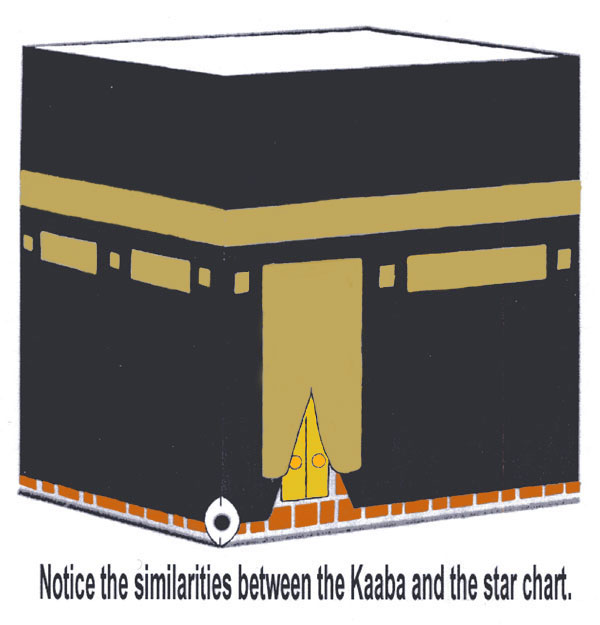
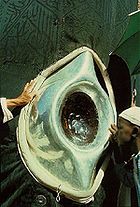

192.jpg)
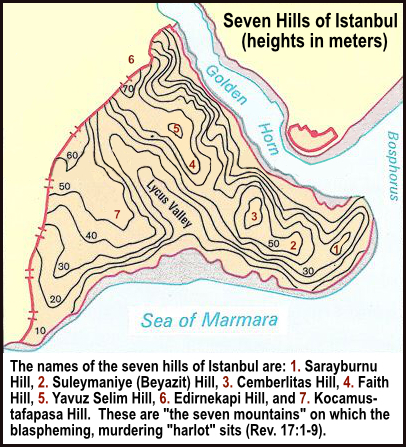
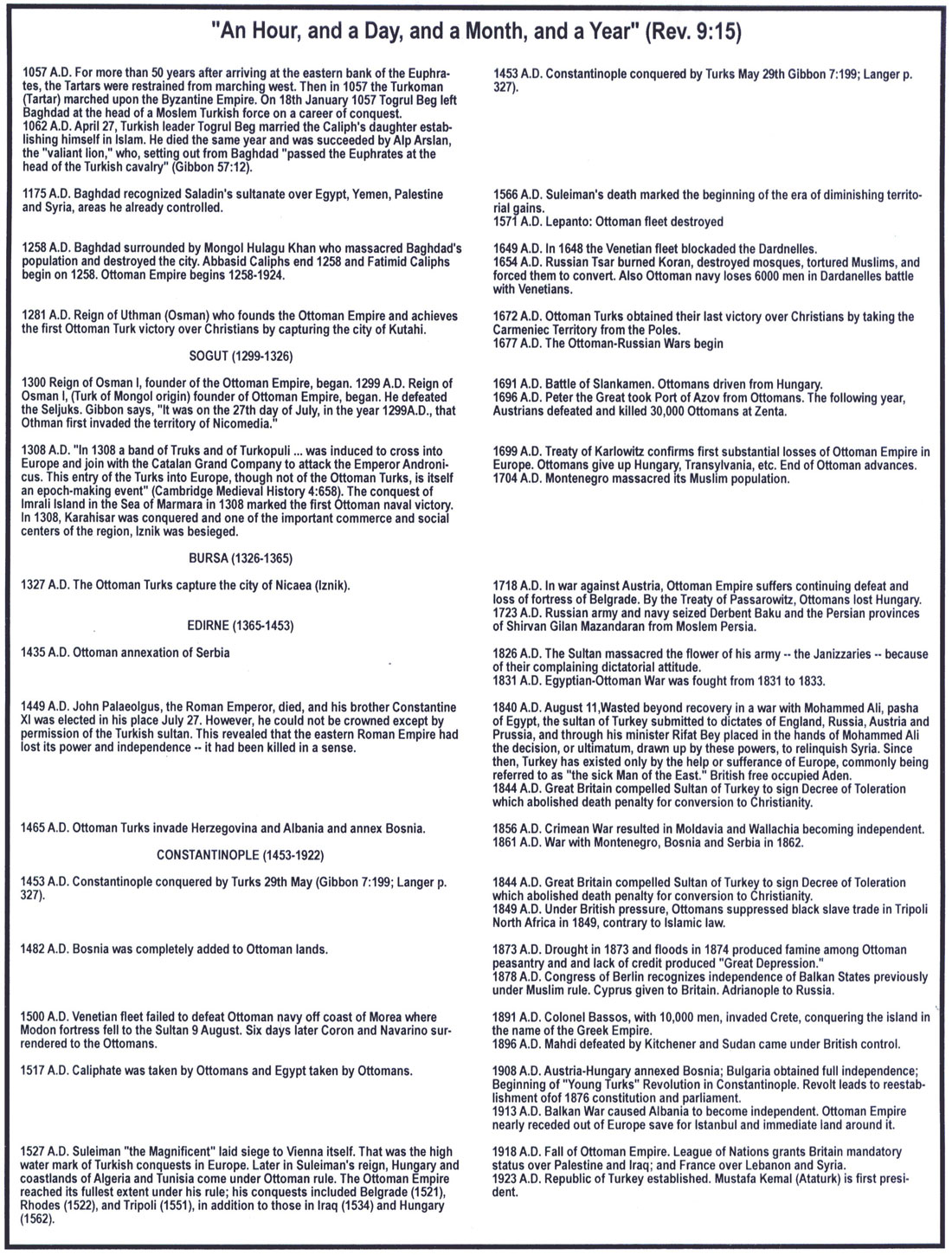
Next Lesson: Greeks Escape Constantinople With Illuminating Manuscripts Causing Renaissance and Protestant Reformation | Back to Home | Email Us
